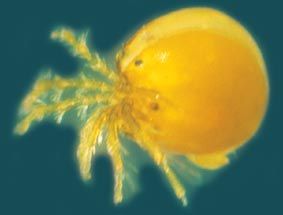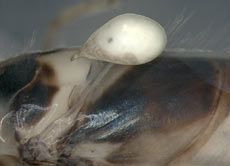Major Group: Acarina
Minor Group: Hydracarina / Hydrachnidiae
|
Descriptive Features: idiosome (body) typically spherical, soft bodied, with little or no sclerotization
2 pairs of eyes on anterolateral margin of body, some more primitive water mites possess a median eye
dorsum and venter with rows of glandularia
dorsum also with 2 pairs of sensory setae, (preocularia and postocularia)
capitulum sits in capitular bay on anteroventral portion of body, bearing a pair of chelicerae and a pair of pedipalps
chelicerae not chelate, composed of 1 segment in Hydrachnidae, 2 segments in all other Hydracarina.
pedipalps consist of 6 segments: coxa, trochanter, femur, patella, tibia and tarsus
adults with 8 legs, juveniles with 6 legs
legs consist of 7 segments: coxa, trochanter, femur, patella, tibia, metatarsus and tarsus
genital field generally situated in the centre of the venter, although in many groups it moves posteriorly, such that it may be terminal, adults have a gonopore within genital field
Size:
|

|
Oxidae |
|
|

|
Astacocrotonidae |
|
Taxonomic Checklist: Families
Anisitsiellidae
Arrenuridae
Astacocrotonidae Astacocroton molle Haswell
Athienemanniidae
Aturidae
Eylaidae Eylais
Frontipodopsidae Frontipodopsis
Hydrachnidae Hydrachna
Hydrodromidae Hydrodroma
Hydryphantidae
Hygrobatidae
Limnesiidae
Limnocharidae
Mideopsidae
Momoniidae
Omartacaridae Omartacarus
Oxidae
Piersigiidae
Pionidae
Pontarachnidae
Torrenticolidae
Unionicolidae
Wettinidae
Zelandothyadidae Australiothyas swaini Cook
|
|
Distribution: all states
Sensitivity Rating: SIGNAL grade 4 - 7
Functional Feeding Group: predators, predators (parasites)
|

|
Murray River at Jingellic , Vic |
|
|
Ecology: Instream habitat: Water mites occur in many freshwater habitats, including, hyporheic gravels in streams and rivers, springs, pools, cold mountain lakes, warm swampy ponds and depositional zones of rivers. Some species are found in the water column, but most live in the vegetation in benthic or littoral areas.
Feeding ecology: All life stages of Hydracarina are carnivorous. Juvenile stages may be parasitic upon larger invertebrates. Free-living forms feed on small crustaceans, insect larva and Protozoa.
Habit:
Life history: The following information is from studies in the USA. Sexes are separate and all species lay eggs. Females lay their eggs singly or in a mass embedded on water plants or other submerged objects, or in a mass between the gills of freshwater mussels or singly in the tissues of the mussel. Newly hatched larvae are active and six-legged. Pupation takes place on the parasitised invertebrate, or within the tissues of the mollusc or fastened to a submerged macrophyte. Most species are not parasitic in the pupal or second larval stage, except for mussel parasites. A second pupal stage is passed through rapidly, usually attached to aquatic plants, again except for mussel parasites. Adults are typically free living.
In New Zealand, eggs are laid at the end of summer. Hatching occurs during April. The first nymphal stage (nymphophan) lasts for three to four months until the second nymph emerges in October to December. Adults may emerge three days after the mite attached itself for the second pupation. Some species take only ten days from the emergence of the nymph to the emergence of the adult. Adults die a few weeks after laying their eggs.
|
| |
Information Sources: Krantz & Walter 2009, Smit 2001, 2004, 2007, Harvey & Growns 1998, Harvey 1998, Cook et al. 2000, Wolcott 1905, Stout 1953
Key to Families: Harvey & Growns 1998, Harvey 1998
Key to Genera: Harvey 1998
Key to Species: Harvey 1990b (Anisitsiellidae, incomplete)
Smit 2003 (Arrenurus
(Brevicaudaturus))
Smit 1997 (Arrenuridae: Arrenurus, incomplete)
Harvey 1989 (Arrenuridae: Wuria, additional species)
Wiles 1991 (Aturudae: Albia)
Smit 2010 (Aturidae: Austraturus, males only,
apart from one species)
Harvey & Cook 1988 (Hygrobatidae: Aspidiobates)
Harvey 1989 (Hygrobatidae: Australorivacarus)
Pesic & Smit 2011 (Hydromidae: Hydrodroma)
Harvey 1988 (Hydryphantidae: Mamersa, Pseudohydryphantes, Australasian)
Harvey 1990c (Limnocharidae)
Harvey
1996b (Mideopsidae: Penemideopsis
males)
Harvey 1990d (Momoniidae: Partidomomonia incomplete)
Harvey 1996a (Pionidae)
Smit 2004 (Unionicolidae: Koenikea incomplete)
Smit 2007 (Unionicolidae:
Recifella)
Pesic
& Smit 2012
(Torrenticolidae: Monatractides)
Cook 1986 (incomplete)
LUCID Key: CSIRO 2001
|

|
juvenile mite parasitizing a notonectid bug |
|

|
. |
|
|
|
|